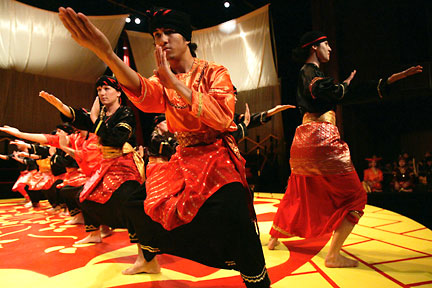
|
UH’s ‘randai’ colorful
but has translation
problem
Take a short but enigmatic story, add musical narration and lengthy segments of colorful dance, and you have "Luck and Loss: Manandin's Gamble," the University of Hawaii at Manoa's second production of "randai," a traditional form of dance-drama from western Sumatra.
|
"Luck and Loss: Manandin's Gamble": Presented by the University of Hawaii-Manoa Department of Theatre and Dance at Kennedy Theatre. Repeats 8 p.m. today and tomorrow, and 2 p.m. Sunday. Tickets are $15 general; $12 for seniors, military and UH faculty and staff; $10 for non-UM students; $3 for UH students with valid Spring 2005 UHM ID. Call 956-7655.
|
Magek Manandin leaves his village and his adoring fiancee to attend a "galanggang" festival in the neighboring kingdom of Singkarak. He gambles with success at first but eventually loses. He also gets framed for stealing a buffalo under unclear circumstances. Manandin's uncle, the king of Sandiang Baka, learns of his plight but ignores his frantic protestations of innocence and tells the authorities to make the punishment harsher.
Will Manandin's neglected fiancee stand by him in his disgrace and dishonor, and give him the strength to redeem himself?
It's all entertaining to watch, but Americans will find the resolution of the conflict enigmatic. It might be self-evident to an Indonesian audience how and why Manandin was framed, why the king of Singkarak took the charges at face value and why Manandin's uncle subsequently buys into his guilt and orders harsher punishment, but Americans will find none of these issues clarified by the dialogue, action or playbill information. Events seem driven by the requirements of the plot rather than by what can be found in the way of characterization and character development.
Why does the apparently benevolent Rajo Duo Baleh, king of Singkarak, emerge as one of the villains of the story? Would an Indonesian audience see Rajo Duo Baleh and the "evil" uncle as upright men of principle and Manandin as a youthful transgressor in need of a lesson?
It is often difficult for student performers in Kennedy Theatre's elaborate cross-cultural productions -- be they randai, kabuki or Chinese opera -- to effectively convey emotion and characterization while concentrating on accurately executing the stylized movements of an unfamiliar art form. Most of the principals in this show recite their lines well, but few reach the levels of performance set by the leads in "Umbuik Mudo."
Gilbert Molina succeeds better than most as the hapless Manandin. Marlon P.H. Apio and Carolyn Sara Covalt have a good early scene as his parents, and Cassandra Wormser suffers nobly as Manandin's loving and patient cousin/fiancee.
Molina shares most of the martial arts action with Nicolas Logue (Rajo Duo Baleh) and Chi Ho Law (Bujang Salamaik), although "silek" plays a smaller role overall than in "Umbuik Mudo" four years ago.
A greater part of the entertainment value this time is in experiencing the interplay between the dancers, and the integration of dance and music in the segments that break up the short dramatic exchanges. Annie Lokomaika'i Lipscomb is an energetic Goreh (leader) of the dance circle, Indonesian guest teacher Mohammad Halim leads the student musicians in providing authentic musical support, and veteran Hawaii randai director Kirstin Pauka deploys her principal performers from both groups.
Set aside expectations of logical plot progression and this is an enjoyable introduction to randai, and a rare opportunity to enjoy one of the expansive cross-cultural productions that UH does like no other Hawaii theater group can.
As with in "Umbuik Mudo," seating is available on three sides of the performance area onstage as well as in the conventional "house seating." Anyone interested in observing the dance/martial arts moves, costumes and instruments up close should arrive early and claim a seat onstage. The next chance to do so probably won't come around until 2009!
[News] [Business] [Features] [Sports] [Editorial] [Do It Electric!]
[Classified Ads] [Search] [Subscribe] [Info] [Letter to Editor]
[Feedback]
